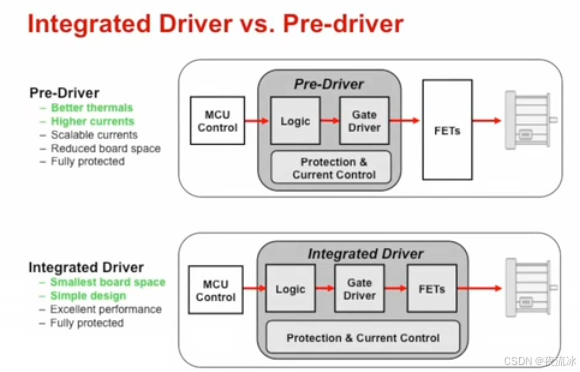TI Video library
Engineer It: When to use a pre-driver vs. an integrated motor
工程设计: 何时使用预驱动器,何时使用集成电机
What is the difference between a pre-driver and an integrated motor driver and how do you choose one over the other?
前置驱动器和集成电机驱动器有什么区别,以及如何取舍?
Think it , Design it, Engineer it.
大家好,我是德州仪器集成电机驱动产品市场经理 Michael Firth。今天,我从基尔比电机实验室来到这里。这里是我们进行电机控制算法高级研发的地方。我今天想花一点时间谈谈预驱动器与集成电机驱动器。它们的主要区别是什么?首先,让我们来看看两种不同架构的框图。
Hello, I'm Michael Firth, Product Marketing Manager for Texas Instruments, Integrated Motor Drive Products. And today, I'm coming to you from Kilby Motor Labs. This is where we do our advanced R&D for motor control algorithms. I'd like to spend a little time today talking about a pre driver versus an integrated motor driver. What are the major differences, and when would you select one versus the other. So to start, let's take a look at the block diagrams of the two different architectures.

因此,你在顶部看到的就是预驱动器。实际上,我这里有一个前置驱动器的例子。这是 DRV8301。
So what you see here at the top is a pre driver. I've actually got here an example of a pre driver. This is the DRV8301.





 最低0.47元/天 解锁文章
最低0.47元/天 解锁文章


















 26
26

 被折叠的 条评论
为什么被折叠?
被折叠的 条评论
为什么被折叠?










